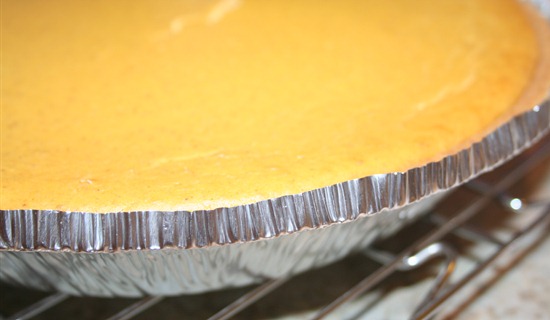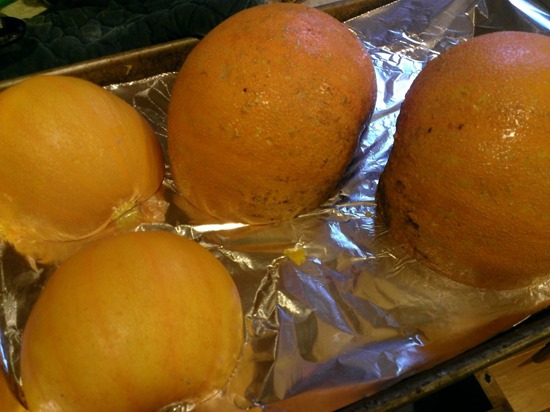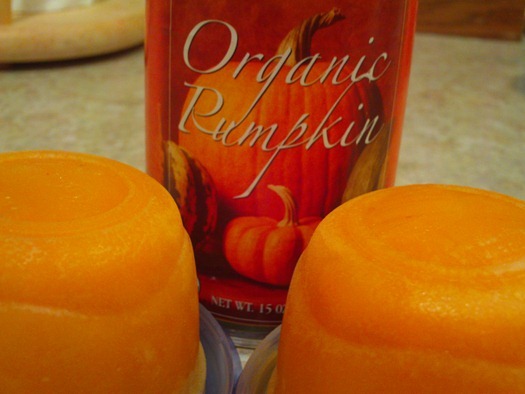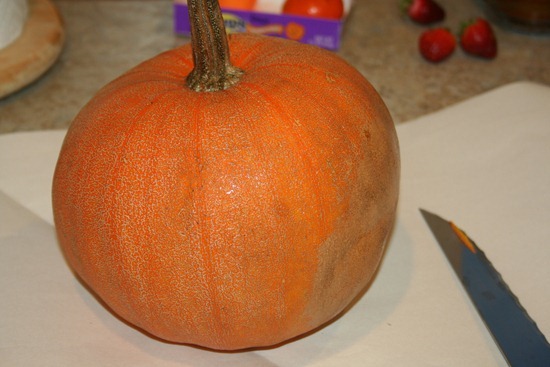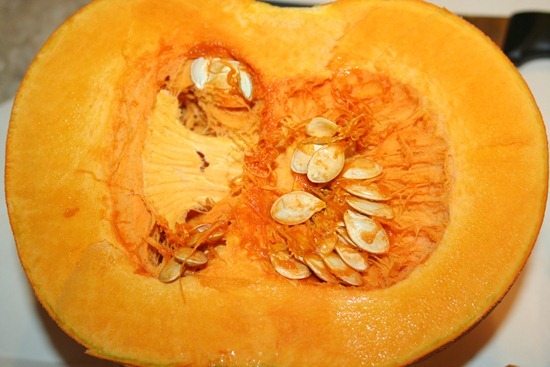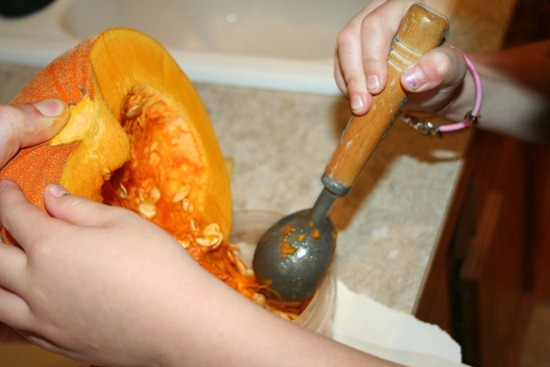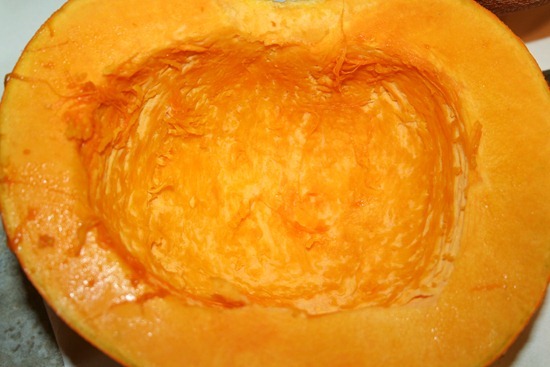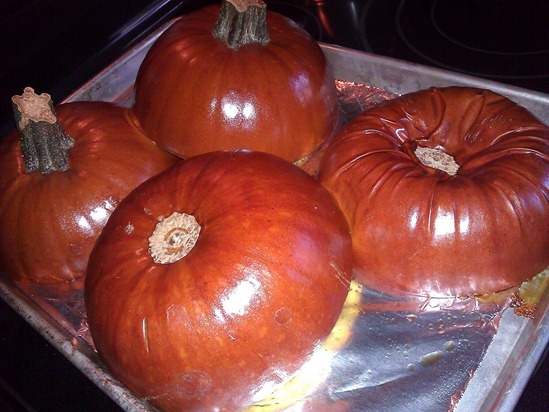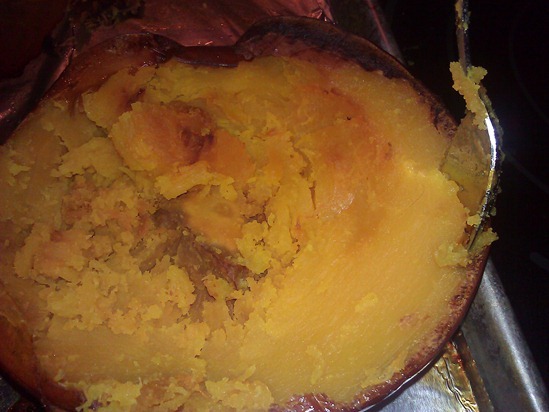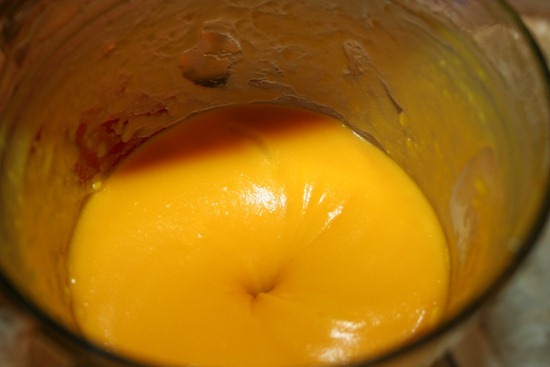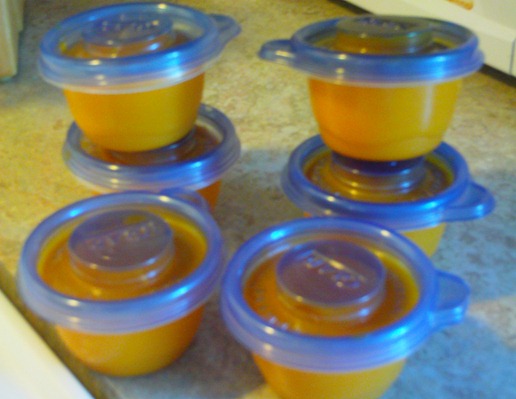How to make Homemade pumpkin bread
After having an abundance of cooked pumpkin after over purchasing on a couple of organic pie pumpkins I decided to make some pumpkin bread, here is the recipe I have always had great results with.
Ingredients
- 2 cups cooked pumpkin plus 1 cup or water or 16 oz can of canned pumpkin plus 1.25 cups water
- 3.5 cups all purpose flour
- 2 tsp. baking soda
- 3 cups sugar
- 4 eggs
- 1 cup vegetable oil
- 1.5 tsp. kosher salt
- 2 tsp. cinnamon
- 2 tsp. nutmeg
Directions
- Preheat oven to 350 F.
- Combine flour, baking soda, salt, cinnamon, nutmeg, and sugar into a large mixing bowl.
- In a separate bowl whisk eggs, water, oil and pumpkin.
- Slowly at wet ingredients to dry ingredients and blend until well combined.
- Pour into two lightly greased and floured bread loaf pans.
- Bake for 1 hour and test if done by inserting a knife into the middle of the loaf and when it comes out clean it is done.
- Let cool for 30 minutes, top with aluminum foil and place into your refrigerator and let cool overnight.
Simple pumpkin cheescake recipe
9.4 years ago pumpkin, puree, recipe
I made my first pumpkin cheesecake a few years back and has been a recurring addition to our Thanksgiving dinner ever since then…though baking cheesecakes can be/sound a bit intimidating with a few techniques mentioned below it can be pretty easy to have success on your first attempt. In addition this is also a great way to get rid of my masses of pumpkin puree in my freezer saved from this years pumpkins
- 1 graham cracker crust (homemade or store bought)
- 16 oz. of crème cheese (2 – 8 oz. packages)
- ⅔ cup brown sugar
- 1.5 cup of pumpkin puree (or one can of store bought pumpkin)
- 1 teaspoon vanilla
- ¾ teaspoon cinnamon
- ¼ teaspoon nutmeg
- ¼ teaspoon ginger
- 2 eggs
- Preheat oven at 350 degrees
- Beat cream cheese until it appears fluffy
- Add sugar, pumpkin, vanilla, cinnamon, nutmeg, and ginger and and beat until well combined
- Add eggs one at a time and beat until creamy
- Place empty graham cracker crust to a cookie sheet and place in oven with rack pulled out. Fill with mixture until full and carefully push rack (and cheesecake) into the oven. You can attempt this pour and move away from the oven but unless your day job is working on a bomb squad most likely this will lead to some filling on the floor and yourself.
- Bake for 50-60 minutes keeping a careful eye on the edges if you start to see some browning your cheesecake is done cooking.
- At this time I turn off the oven and crack open the door a few inches to let things cool down gradually, optionally you can pull it out and place the cheesecake on a cooling rack for 1-2 hours. Though if you are in a hurry you can speed up the cooling by placing your cheesecake in the refrigerator after 10-15 minutes though you significantly increase the chance of causing a ugly split down the middle of your nice cheesecake.
- After cooling for 1-2 hours cool or overnight(if you can wait that long)
Tags: recipes
Crossbred pumpkin and zucchini? Is that a pumpzini or Pucchini?
9.7 years ago Pucchini, pumpkin, zucchini
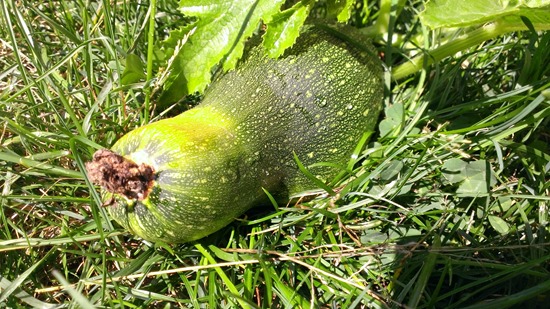
So past few years I have been collecting seeds from my luxury pie pumpkins to plant the next year. Everything was going as planned, they sprouted on the grow box brought them outside when the temperature was right and planted them in the garden. They made a long vine and sprawled throughout my hard, then came the fruit…
Instead of the typical nice small round baby pumpkin, I saw something that more closely resembled a zucchini. So my best guess is I made a crossbreed, which is not surprising since I have a pretty small area in my yard of southern facing full sun so pumpkins and zucchinis are planted in near vicinities.
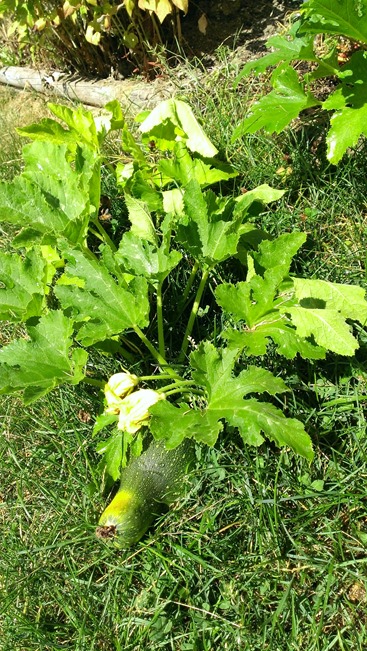
Not expecting to be the first person in history to do this I went online and found a few other references of other people doing this as well. Sounds like my best bet is to roast it like other squash and is supposed to have a pretty creamy texture. Will let you know how it turns out in a couple weeks…
Pumpkin pancakes with pumpkin spice whipping cream
10.5 years ago pumpkin, puree, recipe, Uncategorized
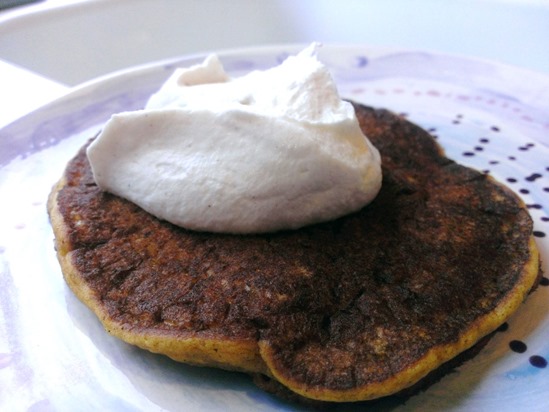
My seed collection from my Winter Luxury Pie pumpkin I purchased a few years back finally paid off and I was able to produce a couple of decent sized pumpkins which should provide me enough pumpkin goo (canned pumpkin) to make plenty of baked goods this fall. For those who have not made their own pumpkin goo the process is very easy…even easier this year with my new food processor (no need to add bit of water to help my struggling magic bullet I have used in the past)
So with about a gallon of pumpkin puree on hand I froze about 3/4 of it by spooning some into silicon muffin cups, freezing for a couple hours, adding to freezer bag and repeat.
With what I had left seemed like a good idea would be pumpkin pancakes which I made this morning with the following recipe.
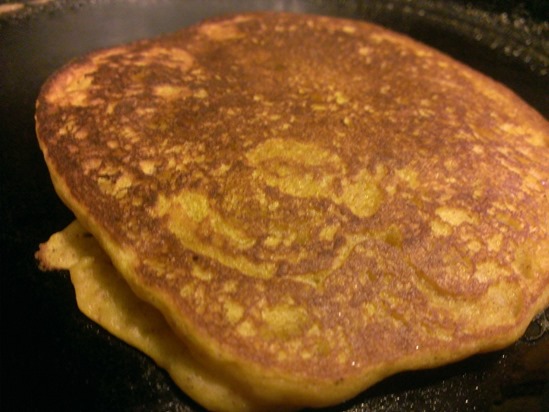
- 1.5 cups milk
- 1 cup pumpkin puree
- 1 egg
- 2 tablespoons vegetable oil
- 2 tablespoons vinegar
- 2 cup all purpose flour
- 2 tablespoons brown sugar
- 1 teaspoon white sugar
- 2 teaspoons baking powder
- 1 teaspoon baking soda
- 2.5 teaspoons pumpkin spice (1 tsp allspice, 1 tsp cinnamon, ½ teaspoon ginger)
- ½ teaspoon salt
- Mix milk, pumpkin, egg, oil and vinegar in bowl.
- In separate bowl combine flour, sugars, baking powder, baking soda, spices, and salt and stir until well combined.
- Stir flour mixture into pumpkin mixture and mix just enough to combine (over mixing can lead to chewy pancakes)
- Heat a griddle or frying/cast iron pan on medium-high heat and pour ¼-1/3 cup of batter into pan and flip when brown and serve.
Nutrient density of vegetables in your garden
10.9 years ago broccoli, leaves, lettuce, nutrients, parsley, pumpkin, Uncategorized

Just out of curiosity I got my hands on the USDA food database and had a little fun in Excel and the results were pretty interesting. Assuming I wanted to figure out what vegetables I could grow in my garden had the highest nutrient density. I wrote a formula for each nutrient from Vitamin A to Zinc what percentage rank across all of the foods did the item have. I then summed up these percentages based on 100 calories consumed to create an overall score and grouped by average across the categories as a “Nutrient Density Score.”
The results were pretty interesting and discovered some new plants I should try consuming this year.
Top 10 most nutrient dense vegetables
| Rank | Vegetable | Score | Nutrients with significant content |
| 1 | Pumpkin leaves | 24.0 | Potassium, Phosphorus, Magnesium, Leucine, Tyrosine, Threroline, Isoleucine, Phenylalanie |
| 2 | Spinach | 23.4 | Calcium, Potassium, Phosphorus, Zinc, Folate, Magnesium, Beta carotene, Tyrosine, Threroline, Isoleucine |
| 3 | Mustard Greens | 23.0 | Calcium, Potassium, Phosphorus, Vitamin C, Vitamin A, Folate, Beta carotene, Tyrosine, Arginine |
| 4 | Broccoli | 23.0 | Calcium, Phosphorus, Zinc, Pantothenic acid, Folate, Aspartic acid, Glutamic acid, Valine |
| 5 | Asparagus | 22.6 | Phosphorus, Potassium, Zinc, Copper, Selenium, Niacin, Folate, Aspartic acid, Glutamic acid |
| 6 | Turnip Greens | 22.6 | Calcium, Potassium, Beta carotene, Tyrosine, Threroline, Isoleucine, Phenylalanie, Leucine, Valine |
| 7 | Pak-Choi | 22.3 | Calcium, Phosphorus, Potassium, Vitamin C, Folate, Beta carotene, Glutamic acid, Isoleucine, Alanine |
| 8 | Swiss Chard | 21.5 | Magnesium, Phosphorus, Potassium, Copper, Beta carotene, Isoleucine, Phenylalanie |
| 9 | Green Leaf Lettuce | 21.5 | Phosphorus, Potassium, Manganese, Vitamin A, Beta carotene, Isoleucine |
| 10 | Beet Greens | 21.4 | Calcium, Phosphorus, Potassium, Zinc, Copper, Manganese, Pantothenic acid, Beta carotene |
As you can see everything in the top ten is at least the color green with most of the plants being leafy vegetables. Some honorable mentions rounding up the top 20: Chives, Kale, Zucchini, Corn salad, Okra, Cauliflower Greens, Parsley, Mushrooms, Collards, Red leaf Lettuce.
So as you know vegetables contain the most nutrients the shorter the time between they are harvested and then consumed so anywhere you can shave off a few hours of this process is to your advantage, so to benefit the most for the nutrients in your food some of the above plants are some great options.
So how about the bottom, or the top ten least nutrient dense vegetables in your garden?
Bottom 10 least nutrient dense vegetables
| Rank | Vegetable | Score |
| 1 | Indian Squash | 8.4 |
| 2 | Shiitake Mushrooms | 9.4 |
| 3 | Potatoes | 9.5 |
| 4 | Jerusalem Artichoke | 9.6 |
| 5 | Parsnips | 9.7 |
| 6 | Lemon grass | 9.7 |
| 7 | Pumpkin flowers | 10.3 |
| 8 | Arrowroot | 10.8 |
| 9 | Tomatillos | 10.9 |
| 10 | Rhubarb | 10.9 |
Now don’t get me wrong many of the plants in the above list may still have plenty of nutritional value it is just that compared to the competition they lack the shear concentration of nutrition and the diversity across the spectrum.
I know for me I am planning on trying some pumpkin leaves this year. Sounds like you just dice them up and sauté with some oil and throw in some garlic at the end and sounds like the leaves should actually be pretty sweet tasting…I will be sure to post of the success or failure of cooking pumpkin leaves.
How to make pumpkin puree
11.6 years ago cheap, pumpkin, puree
It is that time of year again to stock up on some pumpkin puree from some fresh pumpkins. Not sure if it is the 3rd daughter or just getting older but this year I have come up with an ever faster way to convert pumpkins into puree. Not only does this give you a better tasting pie, but given a organic pumpkin cost $6 a can you also save quite a bit of money with just a little additional work.
Step 1: Clean the pumpkin. Use a little water and scouring pad to remove loose dirt
Step 2: Remove stem and cut pumpkin in half. This will take a little muscle to get through but using a serrated blade should make quick work of this little pumpkin.
Step 3: Scoop out seeds and innards. Using an ice cream scoop. scrape out the seeds and the stringy innards, you don’t have to get this completely clean as you can see below. I also decided to save a few seeds with hopes to grow my own sugar pumpkins next year using the seed saving techniques I have wrote about last year.
Step 4: Cook the pumpkin. Places halved pumpkins on a cookie sheet. Place in a preheated oven at 350F and cook the pumpkin for 1.5-2 hours. The pumpkin is done cooking when you can slice through the pumpkin flesh with an edge of a fork with almost no effort.
Step 5: Scape out cooked pumpkin. When the pumpkins are cool enough to handle simply take a large spoon and scrape out the cooked pumpkin and scoop into a large bowl being careful to not scrape too hard and accidentally get some pumpkin skin in the mix.
Step 6: Blend. Use a large metal spoon to scape the pumpkin away from the skin and place into a blender and blend until smooth. Typically this can be as much as 1/3 water to 2/3 cooked pumpkin to get a good vortex going like above.
That is it. With my 5 pound pumpkin I purchased for $5 I got 6 cups of pumpkin puree, which is enough to make 3 pumpkin pie or 6 loafs of pumpkin bread and if my math is right about $30 compared to buying the canned variety. After making a pie and a loaf of pumpkin bread this left me with 3 cups of pumpkin goo, which I put in 6 half-cup containers which I froze to make some more pie for Thanksgiving.

